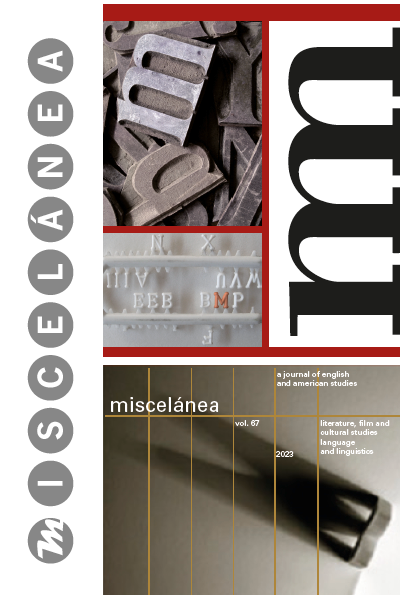Buscando atención: Lectura comparada de Robert Browning y Edgar Allan Poe
DOI:
https://doi.org/10.26754/ojs_misc/mj.20236808Palabras clave:
Robert Browning, Edgar Allan Poe, influencia, relato corto, monólogo dramáticoResumen
El presente artículo explora la posible influencia entre ciertas obras de Robert Browning y Edgar Allan Poe, que fueron compuestas y publicadas en fechas muy cercanas en el tiempo, tratan temas similares y comparten estrategias y técnicas literarias. Aunque la posibilidad de que pudieran haber estado leyendo el trabajo del otro está respaldada por sus respectivas correspondencias con Elizabeth Barrett Browning, estas similitudes entre un cierto número de sus obras también podrían atribuirse a la experimentación literaria como medio para destacar en un mercado literario ferozmente competitivo que debía complacer tanto el gusto popular como el crítico. Este artículo compara las similitudes en la elección del tono y el evento sensacionalista, así como el uso de la voz, en una lista restringida de títulos que coinciden tanto en el tiempo de publicación como en el tema para plantear la cuestión de la influencia en un contexto histórico controvertido cuando el plagio y la innovación radical eran igualmente problemáticos.
Descargas
Referencias
AIKEN, Susan Hardy. 1979. “‘Hy, Zy, Hine’ and Browning’s Medieval Sources for ‘Soliloquy of the Spanish Cloister’”. Victorian Poetry 17 (4): 377-383.
ALTERTON, Margaret. 1933. “An Additional Source for Poe’s ‘The Pit and the Pendulum’”. Modern Language Notes 48 (6): 349-356.
BEARD, Michael. 1978. “The Epigraph to Poe’s ‘Berenice’”. American Literature 4 (49): 611-613.
BENNET, Alice. 2018. Contemporary Fictions of Attention. Reading and Distraction in the Twenty-First Century. London and New York: Bloomsbury Academic.
BROWNING, Robert. 1837. Strafford: An Historical Tragedy. Project Guttenberg. <https://www.gutenberg.ca/ebooks/browning-strafford/browning-strafford-00-h.html>. Accessed August 15, 2021.
BROWNING, Robert. 1910. Poems of Robert Browning. London, New York, Toronto, Melbourne: Oxford U.P.
BROWNING, Robert. 1981. “Essay on Shelley”. In Collins, T.J. (ed.) Robert Browning: The Poems. 2 vols. New Haven and London: Yale U.P.: 1001-1013.
CLARK, David L. 1929. “The Sources of Poe’s ‘The Pit and the Pendulum’”. Modern Language Notes 44 (6): 349-356.
ERICKSON, Lee. 1984. Robert Browning: His Poetry and His Audience. Ithaca: Cornell U.P.
FISHER, Benjamin F. 1999. “Poe in Britain”. In Vines, L. Davis (ed.) Poe Abroad: Influence, Reputation, Affinities. Iowa: University of Iowa Press: 52-61.
FORCLAZ, Roger. 1968. “A Source for ‘Berenice’ and a Note on Poe’s Reading”. Poe Newsletter 1 (2): 25-27.
FOUCAULT, Michel. 1988. Madness and Civilization. A History of Insanity in the Age of Reason. New York: Vintage Books.
HARRISON, Kimberly and Richard FANTINA. 2006. Victorian Sensations. Essays on a Scandalous Genre. Columbus: Ohio State U.P.
HAYES, Kevin J. 2000. Poe and the Printed World. Cambridge: Cambridge U.P.
HIRSCH, David H. 1969. “Another Source for ‘The Pit and the Pendulum’”. Mississippi Quarterly 23 (1): 35-43.
JOHN, Juliet. 2009. “Melodrama and its Criticism: An Essay in Memory of Sally Ledger”. 19: Interdisciplinary Studies in the Long Nineteenth Century 8: 1-20.
LOUCKS, James F. 1974. “‘Hy, Zy, Hine’ and Peter of Abano”. Victorian Poetry 12 (3): 165-169.
MABBOT, Thomas O. 1978. The Collected Works of Edgar Allan Poe. Vol. II: Tales and Sketches. Cambridge (MA): Belknap Press of Harvard U.P.
MAILLOUX, Steven. 1982. Interpretive Conventions. The Reader in the Study of American Fiction. Ithaca and London: Cornell U.P.
MARTENS, Britta. 1985. Browning, Victorian Poetics and the Romantic Legacy. Challenging the Personal Voice. Surrey: Ashgate Publishing Ltd.
MAXWELL, Catherine. 1993. “Browning’s ‘Porphyria’s Lover’”. Explicator 52 (1): 27-30.
MONTEIRO, G. 1985. “‘I said Frà Pandolf by Design’: Browning’s ‘My Last Duchess’”. Victorian Poetry 23 (2): 194-195.
NEWLYN, Lucy. 2000. Reading, Writing, and Romanticism. The Anxiety of Reception. Oxford and New York. Oxford U.P.
OPPENHEIM, Janet. 1988. The Other World. Spiritualism and Psychical Research in England 1850-1914. Cambridge: Cambridge U.P.
PITTS, Gordon. 1966. “Browning’s ‘Soliloquy of the Spanish Cloister’: ‘Hy, Zy, Hine’”, Notes and Queries 13 (9): 339-340.
POE, Edgar Allan. 1846. “The Philosophy of Composition”. Graham’s Magazine 4 (28): 163-167. <http://www.eapoe.org/works/essays/philcomp.htm>. Accessed September 11, 2021.
POE, Edgar Allan. 2002. The Complete Tales and Poems of Edgar Allan Poe. Ed. W.S. Scott. New York: Castle Books.
REYNOLDS, David S. 1988. Beneath the American Renaissance. The Subversive Imagination in the Age of Emerson and Melville. Cambridge and London: Harvard U.P.
SACHSMAN, David B. and David W. BULLA. 2013. Sensationalism, Murder, Mayhem, Mudsliding, Scandals, and Disasters in 19th-Century Reporting. New Brunswick and London: Transaction Publishers.
THOLONIAT, Yann. 2011. “The Printed Voice”. In Martiny, E. (ed.) A Companion to Poetic Genre. Chichester: John Wiley and Sons.
Descargas
Publicado
Número
Sección
Licencia
Derechos de autor 2023 MIRIAM SANTIAGO

Esta obra está bajo una licencia internacional Creative Commons Atribución-NoComercial 4.0.


